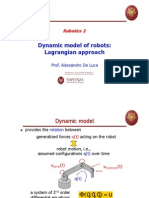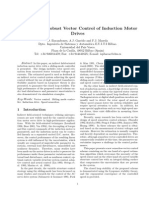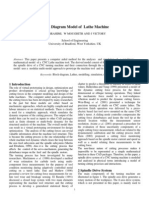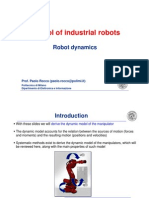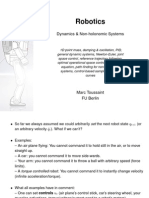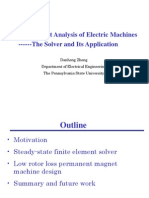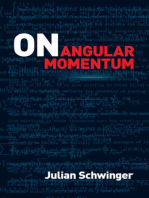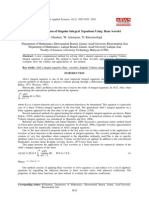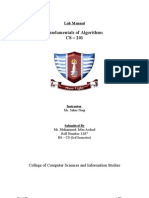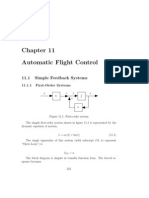ADL Dottorato2011 Part1 Slides
ADL Dottorato2011 Part1 Slides
Uploaded by
Dennis SanCopyright:
Available Formats
ADL Dottorato2011 Part1 Slides
ADL Dottorato2011 Part1 Slides
Uploaded by
Dennis SanCopyright
Available Formats
Share this document
Did you find this document useful?
Is this content inappropriate?
Copyright:
Available Formats
ADL Dottorato2011 Part1 Slides
ADL Dottorato2011 Part1 Slides
Uploaded by
Dennis SanCopyright:
Available Formats
Dottorato di Ricerca in Ingegneria dei Sistemi
Corso: Modellistica e Controllo di Robot con Giunti Flessibili
DIS, Febbraio 2011
Part 1: Modeling and Control
of Robots with Elastic Joints
Alessandro De Luca
Dipartimento di Informatica e Sistemistica (DIS)
Universit`a di Roma La Sapienza
Outline
Motivation for considering joint exibility/elasticity
Dynamic model of robots with joints of constant stiness (= elastic joints (EJ))
reduced, singularly perturbed, or complete model
Inverse dynamics
Sensing requirements and formulation of control problems
Controllers for regulation tasks
motor PD + constant or on-line gravity compensation
Controllers for trajectory tracking tasks
feedback linearization and two-time scale designs
Some modeling and control extensions
mixed rigid/elastic case
dynamic feedback linearization of the complete model
Research issues
References
2
Motivation
in industrial robots, the presence of transmission elements such as
harmonic drives and transmission belts (typically, Scara arms)
long shafts (e.g., last 3-dofs of Puma)
introduce exibility eects between actuating inputs and driven outputs
desire of mechanical compliance in arms (or in legs for locomotion) leads to the
use of elastic transmissions in robots for safe physical interaction with humans
actuator relocation plus cables and pulleys
harmonic drives and lightweight (but rigid) link design
redundant (macro-mini or parallel) actuation
variable elasticity/stiness actuation (VSA)
these phenomena are captured by modeling the exibility at the robot joints
neglected joint exibility limits dynamic performance of controllers (vibrations,
poor tracking, chattering during environment contact)
3
Robots with joint elasticity DEXTER
8R-arm by Scienzia Machinale
DC motors with reductions for joints 1,2
DC motors with reductions, steel cables and
pulleys for joints 38 (all located in link 2)
encoders on motor sides
4
Robots with joint elasticity DLR and KUKA LWR
LWR-II and LWR-III by DLR Institute of Robotics and Mechatronics, and the
latest industrial version by KUKA
7R robot arms with DC brushless motors and harmonic drives
encoders on motor and link sides, joint torque sensors
modular, lightweight (< 14 kg), with 7 kg payload!
5
Robots with joint elasticity DECMMA
2R and 4R prototype arms by Stanford University Robotics Laboratory
parallel macro (at base, with elastic coupling) mini (at joints) actuation
6
Robots with joint elasticity UB Hand
dextrous hand mounted as end-eector of a Puma robot
tendon-driven (static compliance in the grasp)
7
Robots with Variable Stiness actuation VSA-II
1-dof prototype by University of Pisa (being extented to 3R robot arm)
two DC motors, with nonlinear and variable stiness transmission
linear springs, with nonlinear geometric four-bar linkages
8
Joint elasticity in harmonic drives industrial robots
compact, in-line, high reduction (1:200), power ecient transmission element
teon teeth of exspline introduce small angular displacement
video HD
9
Dynamic modeling
open-chain robot with N (rotary or prismatic) elastic joints and N rigid links,
driven by electrical actuators
Lagrangian formulation using motor variables IR
N
(as reected through
reduction ratios) and link variables q IR
N
as generalized coordinates
q
q
2
J
m1
m2
J
m
1
2
I
I
1
r
1 q
1
r
2
m
2
r2
m
1
2
m1
m2
K
2
1
K
10
standing assumptions
A1) small displacements at joints (linear elasticity domain)
A2) axis-balanced motors (i.e., center of mass of rotors on rotation axes)
further assumption on location of actuators in the kinematic chain
A3) each motor is mounted on the robot in a position preceding the driven link
L
1
L
2
L
N - 1
Link 0
Base
Link 1
Joint 1
Link N - 1
Link 2
Link N
Joint 2
World
Frame
Joint N
L
N
11
link (linear + angular) kinetic energy
T
=
N
i=1
T
i
=
N
i=1
_
T
L,
i
+T
A,
i
_
=
N
i=1
1
2
_
m
i
v
T
c,
i
v
c,
i
+
T
i
I
i
_
=
1
2
q
T
M
(q) q
motor linear kinetic energy the mass m
m
i
= m
s
i
+m
r
i
of each motor (stator
+ rotor) is just an additional mass of the carrying link
T
L,m
=
N
i=1
T
L,m
i
=
N
i=1
1
2
m
m
i
v
T
c,m
i
v
c,m
i
=
1
2
q
T
M
m
(q) q
summing up, a symmetric inertia matrix M(q) > 0 results
T
+T
L,m
=
1
2
q
T
(M
(q) +M
m
(q)) q =
1
2
q
T
M(q) q
12
link and motor potential energy due to gravity
U
g
= U
g,
+U
g,m
=
N
i=1
_
U
g,
i
(q) +U
g,m
i
(q)
_
= U
g
(q)
A2) both M, U
g
are independent from
potential energy due to joint elasticity
U
e
=
1
2
(q )
T
K(q )
with diagonal, positive denite N N matrix K of joint stiness
13
simplifying assumption reduced dynamic model of (Spong, 1987)
A4) angular kinetic energy of each motor is due only to its own spinning
T
A,m
=
1
2
T
B
with constant, diagonal, positive denite motor inertia matrix B (reected
through the reduction ratios: B
i
= J
mi
r
2
i
, i = 1, . . . , N)
system Lagrangian
L = T U = (T
+T
L,m
+T
A,m
) (U
g
+U
e
)
=
1
2
q
T
M(q) q +
1
2
T
B
U
g
(q)
1
2
(q )
T
K(q )
= L(q, , q,
)
14
Euler-Lagrange equations
given the set of generalized coordinates p = (q
T
T
)
T
IR
2N
, the Lagrangian
L satises the usual vector equation
d
dt
_
L
p
_
T
_
L
p
_
T
= u
being u IR
2N
the non-conservative forces/torques performing work on p
assuming no dissipative terms and no external forces (acting on links), since the
motor torques IR
N
only perform work on the motor variables we obtain
M(q) q +C(q, q) q +g(q) +K(q ) = 0
B
+K( q) =
link equation
motor equation
with centrifugal/Coriolis terms C(q, q) q and gravity terms g(q) = (U
g
/q)
T
15
Coriolis/centrifugal terms
being the generalized coordinates p = (q
T
T
)
T
, these quadratic terms in the
generalized velocity p are computed by (symbolic) dierentiation of the elements
of the 2n 2N robot inertia matrix
/(p) =
_
M(q) 0
0 B
_
=
_
/
1
/
2
.
.
. /
2N
_
(columns)
using the Christoel symbols (of the second type):
((p, p) p = col p
T
(
i
(p) p
(
i
(p) =
1
2
_
_
_
/
i
p
_
+
_
/
i
p
_
T
_
/
p
i
_
_
_
i = 1, 2, . . . , 2N
thanks to the simple structure of /= /(q), the computation is relevant only
for the upper left block M(q) only C(q, q) q in link equation
16
Model properties
M(q) 2C(q, q) is skew-symmetric
nonlinear dynamic model, but linear in a set of coecients a = (a
r
, a
K
, a
B
)
(including K and B)
Y
r
(q, q, q) a
r
+diagq a
K
= 0
diag
a
B
+diag q a
K
=
for K (rigid joints): q and K(q ) nite value, so that the
equivalent rigid model is recovered (summing up link and motor equation)
_
M(q) +B
_
q +C(q, q) q +g(q) =
there exists a bound on the norm of the gravity gradient matrix
_
_
_
_
_
g(q)
q
_
_
_
_
_
|g(q
1
) g(q
2
)| |q
1
q
2
|, q
1
, q
2
IR
N
17
. . . work out the dynamic model for a case study
q
2
J
m1
m2
J
m
1
2
I
I
1
r
1 q
1
r
2
m
2
r2
m
1
2
m1
m2
K
2
1
K
planar 2R arm with elastic joints (without or with gravity)
18
Singularly perturbed dynamic model
if joint stinesses K = diagK
1
, . . . , K
N
are very large ( rigid joints), the
system exhibits a two-time scale dynamic behavior in terms of link position (q)
and joint deformation torque (z) that can be used for simpler control design
to show this, we use a linear change of coordinates
_
q
z
_
=
_
q
K( q)
_
and rewrite the motor acceleration and the second time derivative of the joint
deformation torque as
= B
1
( z)
z = K(
q) = K
_
B
1
( z) +M
1
(q) (C(q, q) q +g(q) z)
_
= KB
1
+KM
1
(q) (C(q, q) q +g(q)) K
_
B
1
+M
1
(q)
_
z
19
from K, we can extract a common large scalar factor
1
2
1 so that
K =
1
2
K =
1
2
diag
K
1
, . . . ,
K
N
with
K
i
of similar (moderate) amplitude
the second dynamic equation becomes
2
z =
KB
1
+
KM
1
(q) (C(q, q) q +g(q))
K
_
B
1
+M
1
(q)
_
z ()
and represents the fast dynamics associated with the elastic joints, while
M(q) q +C(q, q) q +g(q) = z
represents the slow dynamics of the links
time scaling is made explicit by introducing the fast time variable =
t
in ()
2
z =
2
d
2
z
dt
2
=
d
2
z
d
2
20
Inverse dynamics
given a suciently smooth link trajectory q
d
(t), together with a number of its
time derivatives, compute the required motion torque
d
(t)
the associated motor trajectory
d
(t) is needed
the motor position is computed from the link equation as
d
= q
d
+K
1
(M(q
d
) q
d
+C(q
d
, q
d
) q
d
+g(q
d
))
motor velocity is computed from the rst time derivative of link equation
d
= q
d
+K
1
_
M(q
d
)q
[3]
d
+
M(q
d
) q
d
+
C(q
d
, q
d
) q
d
+C(q
d
, q
d
) q
d
+ g(q
d
)
_
using the notation x
[i]
=
d
i
x
dt
i
21
motor acceleration is computed from the second time derivative of link equation
d
= q
d
+ K
1
_
M(q
d
)q
[4]
d
+2
M(q
d
)q
[3]
d
+
M(q
d
) q
d
+
C(q
d
, q
d
) q
d
+2
C(q
d
, q
d
) q
d
+C(q
d
, q
d
)q
[3]
d
+g(q
d
)
_
nally, the needed torque is computed from the motor equation by substitution
d
= B
d
+K(
d
q
d
) = BK
1
_
M(q
d
)q
[4]
d
+. . . +g(q
d
)
_
+(M(q
d
) +B) q
d
+C(q
d
, q
d
) q
d
+g(q
d
)
this Lagrangian-based scheme may become computationally heavy for large N
a recursive O(N) Newton-Euler inverse dynamics algorithm may be set up,
by including in the forward recursions also the linear/angular link jerks (third
derivatives) and snaps (fourth derivatives) and in the backward recursions also
the rst and second derivatives of the link forces/torques
22
Sensing requirements
full state feedback requires sensing of four variables: q, (link/motor position)
and q,
(link/motor velocity) 4N state variables for a N-dof EJ robot
only motor variables (,
) are available with standard sensing arrangements
(encoder + tachometer on the motor axis)
velocities also through numerical dierentiation of high-resolution encoders
advanced systems have also measures beyond the elasticity of the joints (e.g.,
link position q and joint torque
J
= K(q )(= z) sensors in DLR LWRs)
23
Exploded view of a DLR LWR-III joint
24
Control problems
regulation to a constant equilibrium conguration (q, , q,
) = (q
d
,
d
, 0, 0)
only the desired link position q
d
is assigned, while
d
has to be determined
q
d
may come from the kinematic inversion of a desired cartesian pose x
d
direct kinematics of EJ robots is a function of link variables: x = kin(q)
tracking of a suciently smooth trajectory q = q
d
(t)
the associated motor trajectory
d
(t) has to be determined
again, q
d
(t) is uniquely associated to a desired cartesian trajectory x
d
(t)
other relevant planning/control problems not considered here include
rest-to-rest trajectory planning in given time T
Cartesian control (regulation or tracking directly dened in the task space)
force/impedance/hybrid control of EJ robots in contact with the environment
25
Regulation
a simple linear example
two elastically coupled masses (motor/link) driven on one side (Quanser LEJ)
dynamic model (without damping/friction eects)
m q +k(q ) = 0 b
+k( q) =
using Laplace transform, we can dene two input-output transfer functions of
interest from the force input to . . .
the position of the rst mass (collocated), representing the motor
the position q of the second mass (non-collocated), representing the link
26
Transfer functions of interest
motor transfer function
P
motor
(s) =
(s)
(s)
=
ms
2
+k
mbs
2
+(m+b)k
1
s
2
unstable system with zeros, but passive (zeros always precede poles on the
imaginary axis) stabilization can be achieved via output () feedback
link transfer function
P
link
(s) =
q(s)
(s)
=
k
mbs
2
+(m+b)k
1
s
2
unstable but controllable system as before ( any pole assignment via full
state feedback), but now without zeros!
with damping, pole/zero pairs are moved to the left-hand side of C-plane
27
Typical frequency response of a single elastic joint
10
-1
10
0
-60
-40
-20
0
20
Motor velocity output
Frequency (rad/sec)
M
a
g
n
i
t
u
d
e
(
d
B
)
10
-1
10
0
-100
-50
0
50
100
Frequency (rad/sec)
P
h
a
s
e
(
d
e
g
)
10
-1
10
0
-40
-20
0
20
Link velocity output
Frequency (rad/sec)
M
a
g
n
i
t
u
d
e
(
d
B
)
10
-1
10
0
-300
-200
-100
0
Frequency (rad/sec)
P
h
a
s
e
(
d
e
g
)
antiresonance/resonance behavior on motor velocity output, pure resonance on
link velocity output (weak or no zeros)
28
Feedback strategies with reduced measurements
1) = u
1
(k
P
q +k
D
q) (link PD feedback)
W
(s) =
q(s)
u
1
(s)
=
k
mbs
4
+(m+b)ks
2
+kk
D
s +kk
P
always unstable (spring damping/friction leads to small stability intervals)
2) = u
2
(k
Pm
+k
Dm
) (motor PD feedback)
W
mm
(s) =
k
mbs
4
+mk
Dm
s
3
+[m(k +k
Pm
) +bk] s
2
+kk
Dm
s +kk
Pm
asympotically stable for k
Pm
> 0, k
Dm
> 0 (Routh criterion) as in rigid
systems!
29
3) = u
3
(k
P
q +k
Dm
) (link position and motor velocity feedback)
W
m
(s) =
k
mbs
4
+mk
Dm
s
3
+(m+b)ks
2
+kk
Dm
s +kk
P
asympotically stable for 0 < k
P
< k, k
Dm
> 0 (limited proportional gain)
4) with = u
4
(k
Pm
+k
D
q) (motor position and link velocity feedback) the
closed-loop system is always unstable
caution must be used in dealing with dierent output measures
generalization to a nonlinear multidimensional setting (under gravity) of the most
ecient scheme (motor PD feedback)
video Quanser
30
Regulation with motor PD + feedforward
for regulation tasks, consider the control law
= K
P
(
d
) K
D
+g(q
d
)
with symmetric (diagonal) K
P
> 0, K
D
> 0, and the motor reference position
d
:= q
d
+K
1
g(q
d
)
Theorem (Tomei, 1991) If
min
(K
E
) :=
min
__
K K
K K +K
P
__
>
then the closed-loop equilibrium state (q
d
,
d
, 0, 0) is globally asymptotically stable
31
Lyapunov-based proof
closed-loop equilibria ( q =
= q =
= 0) satisfy
K(q ) +g(q) = 0
K( q) K
P
(
d
) g(q
d
) = 0
adding/subtracting K(
d
q
d
) g(q
d
) (= 0, by denition of
d
) yields
K(q q
d
) K(
d
) +g(q) g(q
d
) = 0
K(q q
d
) +(K
P
+K)(
d
) = 0
or, in matrix form,
K
E
_
q q
d
d
_
=
_
g(q
d
) g(q)
0
_
32
using the Theorem assumption, for all (q, ) ,= (q
d
,
d
) we have
_
_
_
_
_
K
E
_
q q
d
d
__
_
_
_
_
min
(K
E
)
_
_
_
_
_
_
q q
d
d
__
_
_
_
_
>
_
_
_
_
_
_
q q
d
d
__
_
_
_
_
|q q
d
|
|g(q
d
) g(q)| =
_
_
_
_
_
_
g(q
d
) g(q)
0
__
_
_
_
_
and hence (q
d
,
d
) is the unique equilibrium conguration
dene the position-dependent energy function
P(q, ) =
1
2
(q )
T
K(q )+
1
2
(
d
)
T
K
P
(
d
)+U
g
(q)
T
g(q
d
)
its gradient P(q, ) = 0 only at (q
d
,
d
) (using the same above argument)
and
2
P(q
d
,
d
) > 0 (q
d
,
d
) is an absolute minimum for P(q, )
33
the following is thus a candidate Lyapunov function
V (q, , q,
) =
1
2
q
T
M(q) q +
1
2
T
B
+P(q, ) P(q
d
,
d
) 0
its time derivative, evaluated along the closed-loop system trajectories, is
V = q
T
M(q) q +
1
2
q
T
M(q) q +
T
B
+
_
q
_
T
K(q )
T
K
P
(
d
) + q
T
_
U
g
(q)
q
_
T
T
g(q
d
)
= q
T
_
C(q, q) q g(q) K(q ) +
1
2
M(q) q +K(q ) +g(q)
_
+
T
(u K( q) K(q ) K
P
(
d
) g(q
d
))
=
T
_
K
P
(
d
) K
D
+g(q
d
) K
P
(
d
) g(q
d
)
_
=
T
K
D
0
where the skew-symmetry of
M 2C has been used
34
since
V = 0
= 0, the proof is completed using LaSalle Theorem
substituting
(t) 0 in the closed-loop equations yields
M(q) q +C(q, q) q +g(q) +Kq = K = constant ()
Kq = K K
P
(
d
) g(q
d
) = constant ()
from () it follows that q(t) 0, which in turn simplies () into
g(q) +K(q ) = 0 ( )
from the rst part of the proof, the unique solution to ()( ) is q = q
d
,
=
d
and thus the largest invariant set contained in the set of states such
that
V = 0 global asymptotic stability of the set point
35
Remarks on regulation control
if the (minimum) joint stiness min
i=1,...,N
K
i
> , the Theorem assumption
min
(K
E
) > can always be satised by increasing
min
(K
P
)
since the symmetric matrices K and K
P
are assumed diagonal, it is sucient
to analyze the scalar case (N = 1)
det(I K
E
) =
2
(2K +K
P
) +KK
P
min
(K
E
) = K +
K
P
2
_
K
2
+
_
K
P
2
_
2
set K = +, for arbitrary small > 0: the assumption is satised if
K
P
> 2 +
2
for 0 K
P
36
in the presence of model uncertainties, the control law (with K
P
large enough)
= K
P
(
d
) K
D
+g(q
d
)
d
:= q
d
+
K
1
g(q
d
)
provides asymptotic stability, for a dierent (still unique) equilibrium ( q,
)
a version with on-line gravity compensation (De Luca, Siciliano, Zollo, 2005)
= K
P
(
d
) K
D
+g(
)
where
:= K
1
g(q
d
) is a biased motor position measurement
proof uses a modied Lyapunov candidate with
P
t
=
1
2
(q )
T
K(q ) +
1
2
(
d
)
T
K
P
(
d
) +U
g
(q) U
g
(
)
however, the available proof does not relax the assumptions on a minimum
K (structural) and on the need of an associated lower bound involving K
P
(minimum positional control gain)
37
Comparative simulation results on a 2R robot
K
P
= diag180, 180 K
D
= diag80, 80 ( 133)
0 2 4 6 8 10
0.5
0
0.5
1
1.5
2
[s]
[
r
a
d
]
LINK POSITIONS
0 2 4 6 8 10
100
0
100
200
300
400
[s]
[
N
m
]
MOTOR TORQUES
0 2 4 6 8 10
0.5
0
0.5
1
1.5
2
[s]
[
r
a
d
]
LINK #1 POSITION ERROR
0 2 4 6 8 10
0.05
0
0.05
0.1
0.15
[s]
[
r
a
d
]
LINK #2 POSITION ERROR
on-line (solid) vs. constant (dashed) gravity compensation
38
Comparative simulation results on a 2R robot
K
P
= diag150, 150 K
D
= diag50, 50 (suciency is violated)
0 2 4 6 8 10
0.5
0
0.5
1
1.5
2
[s]
[
r
a
d
]
LINK POSITIONS
0 2 4 6 8 10
100
0
100
200
300
400
[s]
[
N
m
]
MOTOR TORQUES
0 2 4 6 8 10
0.5
0
0.5
1
1.5
2
[s]
[
r
a
d
]
LINK #1 POSITION ERROR
0 2 4 6 8 10
0.1
0.05
0
0.05
0.1
0.15
0.2
0.25
[s]
[
r
a
d
]
LINK #2 POSITION ERROR
on-line (solid) vs. constant (dashed) gravity compensation
39
Further remarks on regulation control
a stronger result is obtained using on-line quasi-static gravity cancellation (Kugi,
Ott, Albu-Schaer, Hirzinger, 2008)
= K
P
(
d
) K
D
+g( q)
where q = q() is obtained by solving iteratively, at any given position
g( q) +K( q ) = 0 q
i
= K
1
g(q
i1
)
the sequence q
0
= , q
1
, q
2
, . . . converges (in few iterations) to q thanks to
a contraction mapping result structural assumption min
i=1,...,N
K
i
> is
kept, while any K
P
> 0 is sucient
an even stronger result can be obtained using a nonlinear PD law, including
dynamic gravity cancellation on the link dynamics (De Luca, Flacco, 2011),
based on the feedback equivalence principle any K > 0 and K
P
> 0 will
be sucient
40
Trajectory tracking
assuming that
q
d
(t) C
4
(fourth derivative w.r.t. time exists)
full state is measurable
we proceed by system inversion from the link position output q
a nonlinear static state feedback will be obtained that decouples and exactly
linearizes the closed-loop dynamics (set of in-out integrators) for any value K
exponential stabilization of the tracking error is then performed on the linear
side of the transformed problem
a generalized computed torque law
original result (Spong, 1987), revisited without the need of state-space concepts
41
Feedback linearization by system inversion
dierentiate the link equation of the dynamic model (independent of input )
M(q) q +n(q, q) +K(q ) = 0 n(q, q) := C(q, q) q +g(q)
to obtain (notation: q
[i]
= d
i
q/dt
i
)
M(q)q
[3]
+
M(q) q + n(q, q) +K( q
) = 0
still independent from
dierentiating once more (fourth derivative of q appears)
M(q)q
[4]
+2
M(q)q
[3]
+
M(q) q + n(q, q) +K( q
) = 0
the input appears through
and the motor equation
B
+K( q) =
42
substitution of
gives
M(q)q
[4]
+c(q, q, q, q
[3]
) +KB
1
K( q) = KB
1
with
c(q, q, q, q
[3]
) := 2
M(q)q
[3]
+(
M(q) +K) q + n(q, q)
the control law
= BK
1
_
M(q)a +c(q, q, q, q
[3]
)
_
+K( q)
leads to the closed-loop system
q
[4]
= a
N separate input-output chains of four integrators (linearization and decoupling)
43
(q, q, q, q
[3]
) is an alternative globally dened state representation
from the link equation
q = M
1
(q) (K( q) n(q, q))
i.e., link acceleration is a function of (q, , q)
from the rst dierentiation of the link equation
q
[3]
= M
1
(q)
_
K(
q)
M(q) q n(q, q)
_
i.e., link jerk is a function of (q, , q,
) (using the above expression for q)
the control term c(q, q, q, q
[3]
) can be expressed as a function of (q, , q,
),
with an ecient organization of computations
the control law = (q, , q,
, a) can be implemented as a nonlinear static
(instantaneous) feedback from the original state
44
Tracking error stabilization
control design is completed on the linear side of the problem by choosing
a = q
[4]
d
+K
3
(q
[3]
d
q
[3]
) +K
2
( q
d
q) +K
1
( q
d
q) +K
0
(q
d
q)
with q and q
[3]
expressed in terms of (q, , q,
) and diagonal gain matrices
K
0
, . . . , K
3
chosen such that
s
4
+K
3i
s
3
+K
2i
s
2
+K
1i
s +K
0i
i = 1, . . . , N
are Hurwitz polynomials
the tracking errors e
i
= q
di
q
i
on each link coordinate satisfy
e
[4]
i
+K
3i
e
[3]
i
+K
2i
e
i
+K
1i
e
i
+K
0i
e
i
= 0
i.e., exponentially stable linear dierential equations (with chosen eigenvalues)
45
Remarks on trajectory tracking control
the shown feedback linearization result is the nonlinear/MIMO counterpart of
the transfer function q being without zeros (no zero dynamics)
the same result can be rephrased as q is a at output for EJ robots
a nominal feedforward torque ( inverse dynamics!) can be computed o line
d
= B
d
+K(
d
q
d
)
using the previous developments, where
K(
d
q
d
) = M(q
d
) q
d
+n(q
d
, q
d
)
d
= K
1
_
M(q
d
)q
[4]
d
+c(q
d
, q
d
, q
d
, q
[3]
d
)
_
a simpler tracking controller (of local validity around the reference trajectory) is
=
d
+K
P
(
d
) +K
D
(
)
46
Two-time scale control design
for high stiness K the system is singularly perturbed may use a simpler
composite control law, combining a slow and a fast component
=
s
(q, q, t) +
f
(q, q, z, z, t)
where
s
= [
=0
depends only on the slow dynamics of link motion (time t in
the arguments may come from the reference trajectory q
d
(t) to be tracked)
the slow control
s
is designed on the equivalent rigid dynamics (e.g., a feedback
linearization/computed torque or a PD law) obtained by setting = 0 in the
singularly perturbed model, whereas the fast control
f
is used for stabilization
of fast dynamics due to elasticity around the manifold of equivalent rigid motion
the control design is thus split in two parts that work at dierent time scales: we
should avoid to mix back these through feedback (
f
should not contain terms
of order 1/ or higher)
47
use the input =
s
+
f
in the fast dynamics of the singularly perturbed
model (see slide 20), set = 0 (in the limit), and solve for z
z =
_
B
1
+M
1
(q)
_ _
B
1
s
+M
1
(q) (C(q, q) q +g(q))
_
()
= h(q, q,
s
(q, q, t)) a control-dependent manifold in the
4N-dimensional state space of the robot
replacing in the slow dynamics (M(q) q +. . . = z) yields, after simplications
(M(q)+B) q + C(q, q) q + g(q) =
s
slow reduced (2N-dim) system
which is the equivalent rigid robot dynamics (obtained for K !)
for tracking a reference trajectory q
d
(t) C
2
, choose, e.g., a slow control law
based on feedback linearization
s
= (M(q) +B) ( q
d
+K
D
( q
d
q) +K
P
(q
d
q)) +C(q, q) q +g(q)
=
s
(q, q, t)
48
substitute the (partially designed) control law =
s
(q, q, t) +
f
in the fast
dynamics of the singularly perturbed model
2
z =
K
_
B
1
_
s
(q, q, t) +
f
_
_
B
1
+M
1
(q)
_
z
+M
1
(q) (C(q, q) q +g(q))
_
due to time scale separation, the slow variables in the fast dynamics are assumed
to stay constant to their values at t =
t (q = q(
t) = q, q = q(
t) =
q), so
2
z =
K
_
B
1
f
_
B
1
+M
1
( q)
_
z
_
+w( q,
q,
t)
where
w( q,
q,
t) =
K
_
B
1
s
( q,
q,
t) +M
1
( q)
_
C( q,
q)
q +g( q)
__
which in turn, when compared with the manifold dened by (), is rewritten as
w( q,
q,
t) =
K
_
B
1
+M
1
( q)
_
z
z will be treated as a constant parameter in the fast dynamics
49
dening the error on the fast variables as = z z, its dynamics is
(=
2
z) =
K
_
B
1
f
+
_
B
1
+M
1
( q)
_
( z z)
_
=
K
_
B
1
f
_
B
1
+M
1
( q)
_
_
the fast control law should stabilize this linear error dynamics so that the fast
variable z converges to its boundary layer z
with a diagonal K
f
> 0 (but such that
max
(K
f
) _
1
), the choice
f
= K
f
=
f
(q, q, z, z, t)
leads to the exponentially stable error dynamics
+
_
KB
1
K
f
_
+
_
K
_
B
1
+M
1
( q)
__
= 0
(being all matrices positive denite)
the nal control law is =
s
(q, q, t) K
f
z
50
An extension Invariant manifold control design
in the previous analysis, the slow control component
s
works correctly, i.e., it
tracks the reference trajectory q
d
(t) on the equivalent rigid manifold, only for
= 0
to improve the local behavior around an equivalent reduced (2N-dim) manifold
in the IR
4N
state space, we add corrective terms
s
=
0
+
1
+
2
2
+. . .
(in the previous control law,
0
=
s
)
proceed as before for the slow control design, but using a similar expansion of
the resulting manifold (compare with ())
z = h(q, q, z, z, , t)
= h
0
(q, q, z, z, t) +h
1
(q, q, z, z, t) +
2
h
2
(q, q, z, z, t) +. . .
51
in particular, by using up to the second-order correction term, it can be shown
that the resulting manifold can be made invariant
if the initial state starts on the (integral) manifold, the controlled trajectories
will remain on it unless disturbances occur
this result is similar to the one obtained by feedback linearization, but restricted
to the integral manifold
the fast control law is then needed only for recovering from initial state mismatch
and/or disturbances
see (Spong, Khorasani, Kokotovic, 1987)
52
Robots with mixed rigid/elastic joints
consider an N-dof robot having R rigid joints, characterized by q
r
IR
R
, and
N R elastic joints, characterized by link variables q
e
IR
NR
and motor
variables
e
IR
NR
the state dimension is 2R+4(N R) = 4N 2R
under assumption A4), the dynamic model can be rewritten in a partitioned way
(possibly, after reordering of joint variables) as
_
M
rr
(q) M
re
(q)
M
T
re
(q) M
ee
(q)
__
q
r
q
e
_
+
_
n
r
(q, q)
n
e
(q, q)
_
+
_
0
K
e
(q
e
e
)
_
=
_
r
0
_
B
e
e
+K
e
(
e
q
e
) =
e
where q=(q
T
r
q
T
e
)
T
IR
N
, the 2N2N inertia matrix M(q) and its diagonal blocks M
rr
(q)
and M
ee
(q) are invertible for all q, the 2N-vector n(q, q)=(n
T
r
(q, q) n
T
e
(q, q))
T
collects all
centrifugal/Coriolis and gravity terms, K
e
is the diagonal (NR)(NR) stiness matrix of
the elastic joints, and =(
T
r
T
e
)
T
IR
N
are the input torques
53
for the link accelerations (i.e., applying the system inversion algorithm to the
output y = q, after two time derivatives)
_
q
r
q
e
_
=
_
_
_
_
M
rr
M
re
M
1
ee
M
T
re
_
1
0
_
M
ee
M
T
re
M
1
rr
M
re
_
1
M
T
re
M
1
rr
0
_
_
_
_
r
0
_
+
_
r
(q, q,
e
)
e
(q, q,
e
)
_
= ,(q) +(q, q,
e
)
it is easy to see that ,(q) is the decoupling matrix of the system (i.e., all its
rows should be non-zero) as soon as M
re
, 0
if this is the case, ,(q) is always singular (due to the last columns of zeros)
the necessary (and sucient) condition for input-output decoupling by static
state feedback is violated
thus, if M
re
, 0, the more general class of dynamic state feedback may be
needed for obtaining exact linearization of the closed-loop system
54
consider then the case M
re
0; moreover, assume that n
e
= n
e
(q, q
e
) (i.e.,
is independent from q
r
)
this happens if and only if M
rr
= M
rr
(q
r
), M
ee
= M
ee
(q
e
) (using the
Christoel symbols for the derivation of the Coriolis/centrifugal terms from the
robot inertia matrix)
the latter implies also n
r
= n
r
(q, q
r
) a complete inertial separation between
the dynamics of the rigidly driven and of the elastically driven links follows
_
M
rr
(q
r
) q
r
+n
r
(q, q
r
) =
r
M
ee
(q
e
) q
e
+n
e
(q, q
e
) +K
e
(q
e
e
) = 0
B
e
e
+K(
e
q
e
) =
e
55
Theorem 1 (De Luca, 1998) Robots having mixed rigid/elastic joints can be input-
output decoupled (with y = q) and exactly linearized by static state feedback if and
only if there is complete inertial separation in the structure, i.e.
1. M
re
0
2. M
rr
= M
rr
(q
r
), M
ee
= M
ee
(q
e
)
The resulting closed-loop linear system is in the form q
r
= a
r
, q
[4]
e
= a
e
Under the hypotheses of the Theorem, the feedback linearization control law is
r
= M
rr
(q
r
)a
r
+n
r
(q, q
r
)
e
= BK
1
_
M
ee
(q
e
)a
e
+c
e
(q, q, q
e
, q
[3]
e
)
_
where c
e
() := 2
M
ee
(q
e
)q
[3]
e
+(
M
ee
(q
e
) +K
e
) q
e
+ n
e
(q, q
e
) and
q
e
= M
1
ee
(q
e
) (K
e
(
e
q
e
) n
e
(q, q
e
))
q
[3]
e
= M
1
ee
(q
e
)
_
K
e
(
e
q
e
)
M
ee
(q
e
) q
e
n
e
(q, q
e
)
_
56
Theorem 2 (De Luca, 1998) When Theorem 1 cannot be applied, robots having
mixed rigid/elastic joints can always be input-output decoupled (with y = q) and
exactly linearized by a dynamic state feedback law of order m = 2R. The resulting
closed-loop linear system is in the form q
[4]
r
= a
r
, q
[4]
e
= a
e
The following linear dynamic compensator, with state = (
T
r
T
r
)
T
IR
2R
B
r
r
+K
r
(
r
q
r
) =
re
r
= K
r
(
r
q
r
)
having arbitrary (diagonal) B
r
> 0, K
r
> 0 and new input
re
IR
R
, extends the
original mixed rigid/elastic dynamics to the same structure with all elastic joints
_
M
rr
(q) M
re
(q)
M
T
re
(q) M
ee
(q)
__
q
r
q
e
_
+
_
n
r
(q, q)
n
e
(q, q)
_
+
_
K
r
(q
r
r
)
K
e
(q
e
e
)
_
=
_
0
0
_
_
B
r
0
0 B
e
__
e
_
+
_
K
r
(
r
q
r
)
K
e
(
e
q
e
)
_
=
_
re
e
_
feedback linearizable by a static feedback from the extended state . . .
57
A more complete dynamic model of EJ robots
what happens if we remove the simplifying assumption A3)?
for a planar 2R EJ robot, the complete angular kinetic energy of the motors is
T
m1
=
1
2
J
m1
r
2
1
2
1
T
m2
=
1
2
J
m2
( q
1
+r
2
2
)
2
with no changes at base motor and new terms for elbow motor; as a result
T
m
=
1
2
( q
T
T
)
_
_
_
_
_
_
J
m2
0 0 J
m2
r
2
0 0 0 0
0 0 J
m1
r
2
1
0
J
m2
r
2
0 0 J
m2
r
2
2
_
_
_
_
_
_
_
q
_
=
1
2
( q
T
T
)
_
_
_
J
m2
0
0 0
S
S
T
B
_
_
_
_
q
_
the blue terms contribute to M(q) (the diagonal 0 should not worry here!)
58
for NR planar EJ robots, we obtain
M(q) q +S
+C(q, q) q +g(q) +K(q ) = 0
S
T
q +B
+K( q) =
link equation
motor equation
with the strictly upper triangular matrix S representing inertial couplings between
motor and link accelerations
in general, a non-constant matrix S may arise, see (De Luca, Tomei, 1996)
S(q) =
_
_
0 S
12
(q
1
) S
13
(q
1
,q
2
) S
1N
(q
1
,...,q
N1
)
0 0 S
23
(q
2
) S
2N
(q
2
,...,q
N1
)
.
.
.
.
.
.
.
.
.
.
.
.
.
.
.
0 0 0 S
N1,N
(q
N1
)
0 0 0 0
_
_
with new associated centrifugal/Coriolis terms in both link and motor equations
59
Control-oriented remarks
specic kinematic structures with elastic joints (single link, polar 2R, PRP, . . . )
have S 0, so that the reduced model is also complete and feedback linearizable
for the inverse dynamics solution, see (De Luca, Book, 2008)
as soon as S ,= 0, exact linearization and input-output decoupling both fail if
we rely on the use of a nonlinear but static state feedback structure
in order to mimic a generalized computed torque approach (linearization and
decoupling for tracking tasks), we need a dynamic state feedback controller
= (x, ) +(x, )v
= (x, ) +(x, )v
with robot state x = (q, , q,
) IR
4N
, dynamic compensator state IR
m
(yet to be dened), and new control input v IR
N
60
A control extension Dynamic feedback linearization of EJ robots
a three-step design that achieves full linearization and input-output decoupling,
incrementally building the compensator dynamics through the solution of two
intermediate subproblems DFL algorithm in (De Luca, Lucibello, 1998)
presented for constant S ,= 0, works also for S(q)
transformation of the dynamic equations in state-space format is not needed
collapses in the usual linearizing control by static state feedback when S = 0
can be applied also to the complete model of robots with joints of mixed type
some rigid, other elastic, see (De Luca, Farina, 2004)
61
Step 1: I-O decoupling w.r.t.
apply the static control law
= Bu +S
T
q +K( q)
or, eliminating link acceleration q (and dropping dependencies)
=
_
J S
T
M
1
S
_
u S
T
M
1
_
C q +g +K(q )
_
+K( q)
the resulting system is
= u
M(q) q = . . . (2N dynamics unobservable from )
62
Step 2: I-O decoupling w.r.t. f
dene as output the generalized force
f = M(q) q +C(q, q) q +g(q) +Kq
the link equation, after Step 1, is rewritten as f(q, q, q) +Su K = 0
dynamic extension: add 2(i 1) integrators on input u
i
(i = 1, . . . , N) so as
to avoid successive input dierentiation
63
dierentiate 2i times the component f
i
(i = 1, . . . , N) and apply a linear static
control law (depending on K and S)
w = F
w
+G
w
w
so that the resulting input-output system is
d
2i
f
i
dt
2i
= w
i
i = 1, . . . , N
64
Step 3: I-O decoupling w.r.t. q
dynamic balancing: add 2(N i) integrators on input w
i
(i = 1, . . . , N) so
as to avoid successive input dierentiation
dierentiate 2(Ni) times the ith input-output equation (i = 1, . . . , N) after
Step 2, thus obtaining
d
2N
f
dt
2N
=
d
2N
dt
2N
(M(q) q +C(q, q) q +g(q) +Kq) = v
65
apply the nonlinear static control law (globally dened)
v = M(q)v + n(q, q, . . . , q
[2N+1]
) +g
[2N]
(q) +Kq
[2N]
where
n =
2N
k=1
_
2N
k
_
M
[k]
(q)q
[2(N+1)k]
+
2N
k=0
_
2N
k
_
C
[k]
(q, q)q
[2N+1k]
the nal resulting system is fully linearized and decoupled
q
[2(N+1)]
= v
66
Comments on the DFL algorithm
using recursion, the output q and all its derivatives (linearizing coordinates) can
be expressed in terms of the robot + compensator states
[ q q q q
[3]
q
[2N+1]
] = T(q, , q,
, , )
the overall nonlinear dynamic feedback for the original torque
= (q, , q,
, , v)
=
_
_
= . . .
is of dimension m = 2N(N 1)
for a planar 2R EJ robot, m = 4 and nal system with 2 chains of 6 integrators
67
when some of the elements in the upper triangular part of S are zero (depending
on the arm kinematics), then the needed dynamic controller has a dimension m
that is lower than 2N(N 1) the dynamic extensions at steps 2 and 3 are
required only for some joints
for trajectory tracking purposes, given a (suciently smooth) q
d
(t) C
2(N+1)
,
the tracking error e
i
= q
di
q
i
on each channel is exponentially stabilized by
v
i
= q
[2(n+1)]
di
+
2N+1
j=0
K
ji
_
q
[j]
di
q
[j]
i
_
i = 1, . . . , N
where K
0i
, . . . , K
2N+1,i
are the coecients of a desired Hurwitz polynomial
68
Final remarks
for the complete dynamic model of EJ robots, all proposed control laws for
regulation tasks are still valid
under the same conditions, using the same Lyapunov candidates in the proof,
with a more complex nal LaSalle analysis
addition of viscous friction terms on the lhs of the link (D
q
q) and the mo-
tor (D
) equations, with diagonal D
q
, D
> 0, is trivially handled both in
regulation and trajectory tracking controllers
inclusion of spring damping (+D( q
) on the lhs of the link equation, its
opposite in the motor equation) visco-elastic joints
essentially, no changes for regulation controllers
static feedback linearization for tracking tracking tasks becomes ill-conditioned
for D 0, while resorting to a dynamic feedback linearization control will
guarantee regularity (De Luca, Farina, Lucibello, 2005)
69
Research issues
kinetostatic calibration of EJ robots using only motor measurements
unied dynamic identication of model parameters (including K and B)
robust control for trajectory tracking in the presence of uncertainties
adaptive control: available (but quite complex) only for the reduced model with
S = 0 (Lozano, Brogliato, 1992)
Cartesian impedance control with proved stability, see (Zollo, Siciliano, De Luca,
Guglielmelli, Dario, 2005)
tting the results into parallel/redundant actuated devices with joint elasticity
consideration of nonlinear transmission exibility, with passively varying stiness
or independently actuated
. . .
70
References
(De Luca, 1998) Decoupling and feedback linearization of robots with mixed rigid/elastic joints,
Int J Robust and Nonlinear Control, 8(11), 965977
(De Luca, Book, 2008) Robots with exible elements, in Siciliano, Khatib (Eds) Springer
Handbook of Robotics, Springer, 287319
(De Luca, Farina, 2004) Dynamic properties and nonlinear control of robots with mixed rigid/elastic
joints, ISORA04, 97104
(De Luca, Farina, Lucibello, 2005) On the control of robots with visco-elastic joints, IEEE
ICRA05, 42974302
(De Luca, Flacco, 2011) A PD-type regulator with exact gravity cancellation for robotis with
exible joints, IEEE ICRA11, Shanghai, May 2011
(De Luca, Lucibello, 1998) A general algorithm for dynamic feedback linearization of robots with
elastic joints, IEEE ICRA98, 504510
(De Luca, Siciliano, Zollo, 2005) PD control with on-line gravity compensation for robots with
elastic joints: Theory and experiments, Automatica, 41(10), 18091819
71
(De Luca, Tomei, 1996) Elastic joints, in Canudas de Wit, Siciliano, Bastin (Eds) Theory of
Robot Control, Springer, 179217
(Kugi, Ott, Albu-Schaer, Hirzinger, 2008) On the passivity-based impedance control of exible
joint robots, IEEE Trans Robotics, 24(2), 416429
(Lozano, Brogliato, 1992) Adaptive control of robot manipulators with exible joints, IEEE
Trans Automatic Control, 37(2), 174181 (errata exists)
(Spong, 1987) Modeling and control of elastic joint robots, ASME J Dynamic Systems,
Measurement and Control, 109(4), 310319
(Spong, Khorasani, Kokotovic, 1987) An integral manifold approach to the feedback control of
exible joint robots, IEEE J Robotics and Automation, 3(4), 291300
(Tomei, 1991) A simple PD controller for robots with elastic joints, IEEE Trans Automatic
Control, 36(10), 12081213
(Zollo, Siciliano, De Luca, Guglielmelli, Dario, 2005) Compliance control for an anthropomorphic
robot with elastic joints: Theory and experiments, ASME J Dynamic Systems, Measurement
and Control, 127(3), 321328
72
You might also like
- ENSC3001 - Exam NotesDocument13 pagesENSC3001 - Exam NotesGeoffreyWanNo ratings yet
- Modelling of Rotational Mechanical SystemDocument63 pagesModelling of Rotational Mechanical SystemIskandar BellNo ratings yet
- Pid Regulation of Robot Manipulators With Elastic Joints: Jose Alvarez-Ramirez and Ilse CervantesDocument7 pagesPid Regulation of Robot Manipulators With Elastic Joints: Jose Alvarez-Ramirez and Ilse CervantesNikola AndjelicNo ratings yet
- Modeling of Dynamic SystemsmesinDocument19 pagesModeling of Dynamic SystemsmesinRifqi Bustanul FaozanNo ratings yet
- Design and Simulation of Control System For Bearingless Synchronous Reluctance Motor PDFDocument5 pagesDesign and Simulation of Control System For Bearingless Synchronous Reluctance Motor PDFKrishnam NaiduNo ratings yet
- 2 Symposium On Lift and Escalator TechnologiesDocument12 pages2 Symposium On Lift and Escalator TechnologiesfreddyjoertyNo ratings yet
- 03 LagrangianDynamics 1Document28 pages03 LagrangianDynamics 1Terence Deng100% (1)
- FIR 05 Dynamics PDFDocument65 pagesFIR 05 Dynamics PDFselvamNo ratings yet
- Introduction To ROBOTICS: ControlDocument15 pagesIntroduction To ROBOTICS: ControlMANOJ MNo ratings yet
- PID Control Dynamics of A Robotic Arm Manipulator With Two Degrees of Freedom.Document7 pagesPID Control Dynamics of A Robotic Arm Manipulator With Two Degrees of Freedom.David Isai Robles Gonzalez100% (1)
- The Design of A DC Motor Speed ControllerDocument7 pagesThe Design of A DC Motor Speed ControllerStudent HomeNo ratings yet
- Modeling Induction Motors: Abstract: in This Paper, A Novel Technique For On-Line Estimation of MostDocument10 pagesModeling Induction Motors: Abstract: in This Paper, A Novel Technique For On-Line Estimation of Mostseshubabu_999No ratings yet
- Controller Design of Inverted Pendulum Using Pole Placement and LQRDocument7 pagesController Design of Inverted Pendulum Using Pole Placement and LQRInternational Journal of Research in Engineering and Technology100% (1)
- Stator Winding Induction Motor in The EMTPDocument8 pagesStator Winding Induction Motor in The EMTPEleazar Sierra EspinozaNo ratings yet
- Stavrakakis 1988Document4 pagesStavrakakis 1988caxov16116No ratings yet
- The Simplified Dynamic Model of A Robot Manipulator: 1 Problem DescriptionDocument6 pagesThe Simplified Dynamic Model of A Robot Manipulator: 1 Problem DescriptionRudnei BarbosaNo ratings yet
- (1989) - Discrete-Time Modeling and Control of Robotic ManipulatorsDocument13 pages(1989) - Discrete-Time Modeling and Control of Robotic ManipulatorsIsidora ČičaNo ratings yet
- Simulation of Electric Machines and Drive Systems Using Matlab and SimulinkDocument11 pagesSimulation of Electric Machines and Drive Systems Using Matlab and SimulinkmdpkishoreNo ratings yet
- Adaptive State Controller For Inverted Pendulum: Nenad Muškinja, Boris TovornikDocument6 pagesAdaptive State Controller For Inverted Pendulum: Nenad Muškinja, Boris TovornikNeagu AdrianNo ratings yet
- A Sensorless Robust Vector Control of Induction Motor DrivesDocument6 pagesA Sensorless Robust Vector Control of Induction Motor DrivesLava KumarNo ratings yet
- Study of Rotor-Bearing Systems Using Campbell DiagramDocument4 pagesStudy of Rotor-Bearing Systems Using Campbell DiagrammishraenggNo ratings yet
- рисунки PDFDocument18 pagesрисунки PDFLeo KutsNo ratings yet
- Theoretical and Experimental Efficiency Analysis of Multi-Degrees-of-Freedom Epicyclic Gear TrainsDocument21 pagesTheoretical and Experimental Efficiency Analysis of Multi-Degrees-of-Freedom Epicyclic Gear TrainsAmin ShafanezhadNo ratings yet
- Block Diagram Model of Lathe MachineDocument6 pagesBlock Diagram Model of Lathe MachineLamis EssamNo ratings yet
- Dynamic Analysis of Multi Component MooringDocument17 pagesDynamic Analysis of Multi Component MooringlithiumabcNo ratings yet
- Paper Title: Ajay Kumar Gudla and Saikat ChakrabartiDocument5 pagesPaper Title: Ajay Kumar Gudla and Saikat ChakrabartiAshutosh KumarNo ratings yet
- Robot KinematicsDocument33 pagesRobot KinematicsengrasheedNo ratings yet
- Control Systems Systems and Their Representations Unit-1: Ms. P. Geethanjali Asst. Professor (SR) SelectDocument72 pagesControl Systems Systems and Their Representations Unit-1: Ms. P. Geethanjali Asst. Professor (SR) SelectVijay IndukuriNo ratings yet
- Single Axis Text I J Mic 08075 FinalDocument26 pagesSingle Axis Text I J Mic 08075 Finalali almorsedNo ratings yet
- Rusu Marius Sebastian 2Document6 pagesRusu Marius Sebastian 2Mavy GreenNo ratings yet
- G Owacz - V13i2 - 6mathematical Model of DC Motor For Analysis of Commutation ProcesseDocument4 pagesG Owacz - V13i2 - 6mathematical Model of DC Motor For Analysis of Commutation ProcesseDante GuajardoNo ratings yet
- Inverse Kinematics Problem (Ikp) of 6-Dof Manipulator by Locally Recurrent Neural Networks (LRNNS)Document5 pagesInverse Kinematics Problem (Ikp) of 6-Dof Manipulator by Locally Recurrent Neural Networks (LRNNS)yousif al mashhadanyNo ratings yet
- NoncgearDocument6 pagesNoncgearAndreea UdreaNo ratings yet
- MCLECTURE2Document57 pagesMCLECTURE2teknikpembakaran2013No ratings yet
- Introduction To ROBOTICS: OutlineDocument7 pagesIntroduction To ROBOTICS: OutlineshaheerdurraniNo ratings yet
- Robot DynamicsDocument52 pagesRobot Dynamicssilviocus88No ratings yet
- Researches Regarding Functional Stabilization of Electro-Hydraulic Servo-SystemsDocument4 pagesResearches Regarding Functional Stabilization of Electro-Hydraulic Servo-SystemsMaria Gabriela BusteloNo ratings yet
- Dfig Book PDFDocument29 pagesDfig Book PDFSrinivasan PurushothamanNo ratings yet
- Kinematska KontrolaDocument55 pagesKinematska Kontrolaabaafa23423No ratings yet
- Tutorial 2Document4 pagesTutorial 2Sam StideNo ratings yet
- DC DrivesDocument50 pagesDC DrivesjvilasisNo ratings yet
- L2 - Modelling SystemsDocument21 pagesL2 - Modelling SystemsOmer AhmedNo ratings yet
- Vibration EngineeringDocument37 pagesVibration EngineeringAlen Benguit II0% (1)
- General Power System Dynamic Modeling: Signals Dynamics and Control (2010/11)Document16 pagesGeneral Power System Dynamic Modeling: Signals Dynamics and Control (2010/11)Paulo RijoNo ratings yet
- 1 Flexible Link ProjectDocument15 pages1 Flexible Link Projectprasaad08No ratings yet
- Ica20110200012 71434152Document7 pagesIca20110200012 71434152Lê Tuấn MinhNo ratings yet
- FEM SlidesDocument31 pagesFEM SlidesAnya CooperNo ratings yet
- Finite Element Analysis of Electric Machines - The Solver and Its ApplicationDocument43 pagesFinite Element Analysis of Electric Machines - The Solver and Its ApplicationHarshan ArumugamNo ratings yet
- Wheelchair Control and Navigation Based On Kinematic Model and Iris MovementDocument6 pagesWheelchair Control and Navigation Based On Kinematic Model and Iris MovementRafiqul IslamNo ratings yet
- Robust Nonlinear Observer For Flexible Joint Robot Manipulators With Only Motor Position MeasurementDocument6 pagesRobust Nonlinear Observer For Flexible Joint Robot Manipulators With Only Motor Position MeasurementinfodotzNo ratings yet
- Christophgruber Mechatronics2012Document8 pagesChristophgruber Mechatronics2012Hamza NasirNo ratings yet
- Robot Manipulators: Modeling, Performance Analysis and ControlFrom EverandRobot Manipulators: Modeling, Performance Analysis and ControlNo ratings yet
- Advanced Electric Drives: Analysis, Control, and Modeling Using MATLAB / SimulinkFrom EverandAdvanced Electric Drives: Analysis, Control, and Modeling Using MATLAB / SimulinkNo ratings yet
- Analog Dialogue, Volume 48, Number 1: Analog Dialogue, #13From EverandAnalog Dialogue, Volume 48, Number 1: Analog Dialogue, #13Rating: 4 out of 5 stars4/5 (1)
- Simulation of Some Power Electronics Case Studies in Matlab Simpowersystem BlocksetFrom EverandSimulation of Some Power Electronics Case Studies in Matlab Simpowersystem BlocksetRating: 2 out of 5 stars2/5 (1)
- Simulation of Some Power Electronics Case Studies in Matlab Simpowersystem BlocksetFrom EverandSimulation of Some Power Electronics Case Studies in Matlab Simpowersystem BlocksetNo ratings yet
- Student Solutions Manual to Accompany Economic Dynamics in Discrete Time, second editionFrom EverandStudent Solutions Manual to Accompany Economic Dynamics in Discrete Time, second editionRating: 4.5 out of 5 stars4.5/5 (2)
- Handbook of Power Systems Engineering with Power Electronics ApplicationsFrom EverandHandbook of Power Systems Engineering with Power Electronics ApplicationsNo ratings yet
- Representation of Curves and SurfacesDocument36 pagesRepresentation of Curves and SurfacesShahmirBalochNo ratings yet
- Ansys - Bucklinglecture 5Document14 pagesAnsys - Bucklinglecture 5MirceaNo ratings yet
- Gen Math AnnuitiesDocument6 pagesGen Math Annuitiescarlojesusibarra14No ratings yet
- Ec3561 Vlsi Laboratory L T P CDocument6 pagesEc3561 Vlsi Laboratory L T P CsuganyaNo ratings yet
- 数学S1真题集(19 1-24 5)Document253 pages数学S1真题集(19 1-24 5)a63851396No ratings yet
- NN&DP Unit3Document41 pagesNN&DP Unit3rajirk2022No ratings yet
- Numerical Solution of Singular Integral Equations Using Haar WaveletDocument4 pagesNumerical Solution of Singular Integral Equations Using Haar WaveletZhanwen TangNo ratings yet
- Basis Expansions Approaches For Regularized Sequential Dictionary Learning Algorithms With Enforced Sparsity For fMRI Data Analysis - 2017Document12 pagesBasis Expansions Approaches For Regularized Sequential Dictionary Learning Algorithms With Enforced Sparsity For fMRI Data Analysis - 2017bamshadpotaNo ratings yet
- (IJCST-V4I2P16) :anand MehrotraDocument4 pages(IJCST-V4I2P16) :anand MehrotraEighthSenseGroupNo ratings yet
- DesignandimplementationofMultiplierunitMAC ROBADocument10 pagesDesignandimplementationofMultiplierunitMAC ROBANithya Sree JohnsonNo ratings yet
- NLP TheoryManual PDFDocument330 pagesNLP TheoryManual PDFAli ahmedNo ratings yet
- Inferential Statistics Homework Exercise #06Document7 pagesInferential Statistics Homework Exercise #06Eliana Patricia GARCES ORTIGOZANo ratings yet
- Lab Manual 1 Flow Chart Repaired)Document9 pagesLab Manual 1 Flow Chart Repaired)irfan_chand_mianNo ratings yet
- Second Law of Thermodynamics: Chemistry For Engineers - Laboratory Activity 4Document3 pagesSecond Law of Thermodynamics: Chemistry For Engineers - Laboratory Activity 4Harry Harris50% (2)
- Shashank Mahato ResumeDocument2 pagesShashank Mahato ResumeShashank MahatoNo ratings yet
- Digital Signal ProcessingDocument1 pageDigital Signal ProcessingJeevan BalakaNo ratings yet
- Course Offering Fall-2024Document2 pagesCourse Offering Fall-2024Hafsa KamranNo ratings yet
- CNN For Phoneme RecognitionDocument6 pagesCNN For Phoneme RecognitionCarlangaslangasNo ratings yet
- Logic Circuit & Switching Theory Final Quiz 2Document17 pagesLogic Circuit & Switching Theory Final Quiz 2Russel Mendoza100% (1)
- Electric Load Forecasting Literature SurDocument12 pagesElectric Load Forecasting Literature SurAddisu TsehayNo ratings yet
- Lesson 4Document14 pagesLesson 4api-297910907No ratings yet
- Homework3 P&RPDocument2 pagesHomework3 P&RPKarthik V KalyaniNo ratings yet
- Unit VDocument17 pagesUnit VsriramkurisetiNo ratings yet
- CH 11Document15 pagesCH 11Tahir FidanNo ratings yet
- Model Summary PDFDocument1 pageModel Summary PDFDhofirur RamadhanNo ratings yet
- CRD AssignmentDocument9 pagesCRD AssignmentSreenivasNo ratings yet
- Ad 0767826Document347 pagesAd 0767826Cesar ZamudioNo ratings yet
- Placement of Encryption Function: v0.0 CPSC415 Biometrics and Cryptography 1Document19 pagesPlacement of Encryption Function: v0.0 CPSC415 Biometrics and Cryptography 1Harsh ParikhNo ratings yet
- Ross 7 e CH 04Document58 pagesRoss 7 e CH 04Antora HoqueNo ratings yet
- X Variable 1 Line Fit Plot: Regression StatisticsDocument3 pagesX Variable 1 Line Fit Plot: Regression StatisticsAkash VettavallamNo ratings yet






